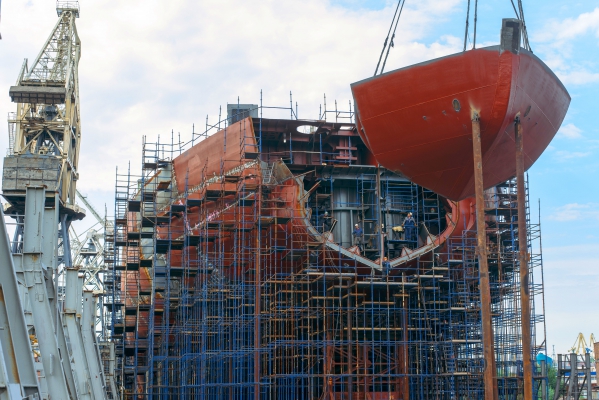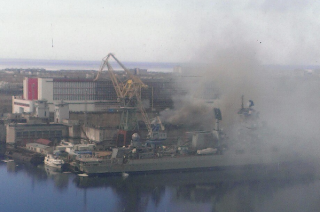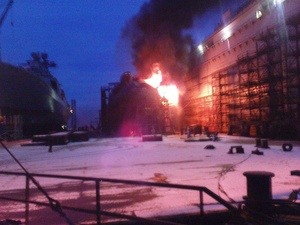
New Managing Director for Bellona Norway
The Board of the Bellona Foundation has appointed former Minister of Climate and the Environment Sveinung Rotevatn as Managing Director of Bellona No...
News

Publish date: August 14, 2015
Written by: Charles Digges
News
St. Petersburg’s Baltic Shipyard has complete the bow section of the much anticipated Arktika nuclear icebreaker, which has been trumpeted as the prototype for Russia’s new generation of “super modern” universal-use nuclear ice smashing fleet, numerous Russian new portals said.
Rossiiskaya Gazeta, one of the oldest and most dependable official mouthpieces of the Kremlin, has reported that the Arktika would be the most powerful icebreaker ever built.
It’s dimensions are also impressive: The ship will be 173 meters long, 34 meters wide, and be able to chew through ice that’s 3 meters thick. Its water displacement will be 33,540 tons.
The Arktika is the prototype vessel for the so-called project 22220 series of icebreakers, and the first of a total of three to be built at the Baltic Shipyard by the Unified Shipbuilding Corporation for a government tender price of 85 billion rubles (or $2.3 billion in 2013, at the time the contract was inked.).
The portnews.ru agency said the Arktika’s bow – which will “plow roads through the ice of the Northern Shipping Route, was sidled into position last week at a dry dock at the Baltic Shipyard.
 A mock up of the Arktika leading ships through icy waters. (Picture: Atomflot)
A mock up of the Arktika leading ships through icy waters. (Picture: Atomflot)
The bow weighs in at 75.5 tons, which Sergei Chernogubovsky, the boat’s chief engineer, said would “take upon itself the whole ice load, and its [bow] stem bar in the substructure, at 160 millimeters thick, will crush and break Arctic ice,” according to the Murmansk–based bport.com news portal.
He said that as of now, 70 percent of the ship’s hull has been built, which falls within the general schedule of it’s completion, meaning the shipbuild is in the home stretch. After the assembly of the stern section, it will be ready to leave dry dock for water, he added in a Russian-language statement released by the Baltic Shipyard.
It is scheduled to be service-ready by December 2017, and will be operated by the Atomflot icebreaker port in Murmansk.
The keel for the Arktika, as the lead ship in the new class of icebreakers, was laid on November 5 2013, said b-port.com.
It will be powered by a new style reactor called the RITM -200 reactor, which produces 175 Megawatts of power.
The Arktika is constructed so it can navigate both Arctic Seas and their river tributaries. It will be used to assist other ships carrying hydrocarbon ores from fields in the Yamal and Gydansk Peninsulas on the Kara Sea shelf to market in the Atlantic and Pacific oceans, said b-port.com.
 A mock up of the Arktika operating at night. (Picture: Atomflot)
A mock up of the Arktika operating at night. (Picture: Atomflot)
The Russian government tried to bring all three icebreakers in for a price of $2.1 billion but the United Shipbuilding Corporation turned down all offers of less that the $2.3 billion from Russian state nuclear corporation Rosatom.
The next two icebreakers are scheduled for delivery in 2019 and 2020. The ships will be run by Atomflot, Rosatom’s nuclear icebreaker port near Murmansk.
Unified Shipbuilding Corporation’s involvement makes some jittery
But there are some concerns surrounding the Unified Shipbuilding Corporation ability to complete projects safely. Its lax safety record since 2011 has seen four conflagrations aboard nuclear submarines that have put in for repairs in shipyards the giant company operates.
 Smoke rising from the Zvezdochka shipyard as the fire on the Orel rages on. (Photo: Flashnord)
Smoke rising from the Zvezdochka shipyard as the fire on the Orel rages on. (Photo: Flashnord)
On in April, the Orel, a Russian nuclear submarine undergoing repairs at the Zvezdochka shipyard, owned by the Unified Shipbuilding Corporation in the Arkangelsk Region, caught fire when welding works went awry. The long burning blaze along the sub’s rubber acoustic hull mean it had to be submerged to fully quell the flames.
In March this year, a fire of trash and debris broke out aboard the Krasnodar decommissioned nuclear submarine at the Nerpa shipyard, which is owned by the Unified Shipbuilding Corporation. The fire was chalked up to careless welding works igniting the rubbish.
In September 2013, the Unified Shipbuilding Corporation’s far eastern Bolshoi Kamen saw another fire break out aboard the decommissioned Pacific Fleet submarine, the Tomsk. The fire broke out in a ballast area of the submarine after a gas-powered saw was used to cut through a grate, setting an old rubber covering, cables and paint on fire.
There were no casualties, but Defense Minister Sergei Shoigu called for increased oversight of facilities where submarines are repaired, and Russia’s Investigative Committee opened an investigation whose results have not been made public.
 Flames belching out of the port side hull area of the Yekaterinburg submarine at Roslyakovo shipyard. (Source: Blogger51)
Flames belching out of the port side hull area of the Yekaterinburg submarine at Roslyakovo shipyard. (Source: Blogger51)
A far more dramatic blaze occurred at the corporations Roslyakovo Shipyard near Murmansk in December 2011, when the operational Yekaterinburg nuclear submarine caught fire due to faulty welding works – while it was still loaded with nuclear weaponry – killing 19.
The fire burned for nine hours as its rubber stealth hull continued to smolder, and was not completely extinguished until rescue workers were again forced to take the extreme measure of submerging the sub.
In all cases, human error was the main cause of the fatal and nearly fatal accidents at Unified Shipbuilding Corporation shipyards.
While Nils Bøhmer, Bellona’s general director and nuclear physicist, said that from a technical point of view, it’s reasonable to have state of the art icebreakers trolling the Arctic, the Unified Shipbuilding Corporation’s history leaves a lot of safety to be desired.
“The past few years have seen a lot of accidents relative to nuclear vessel repair yards that constitute a large human risk factor, no matter how advanced the ships being serviced,” said Bøhmer.
He suggested Russia devote equal focus to safe repair conditions as it is to boosting its nuclear icebreaker prowess.
“This needs to be a focus of the Unified Shipbuilding Corporation, which has shown itself to be lacking a clear understanding and implementation of an effective safety culture,” he said.

The Board of the Bellona Foundation has appointed former Minister of Climate and the Environment Sveinung Rotevatn as Managing Director of Bellona No...

Økokrim, Norway’s authority for investigating and prosecuting economic and environmental crime, has imposed a record fine on Equinor following a comp...

Our op-ed originally appeared in The Moscow Times. For more than three decades, Russia has been burdened with the remains of the Soviet ...

The United Nation’s COP30 global climate negotiations in Belém, Brazil ended this weekend with a watered-down resolution that failed to halt deforest...